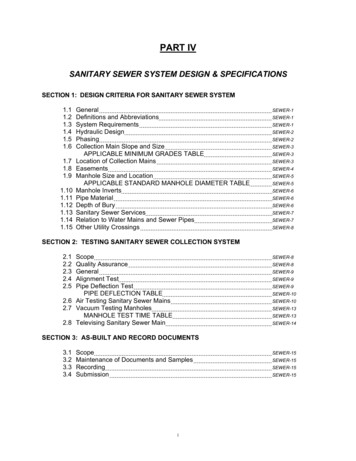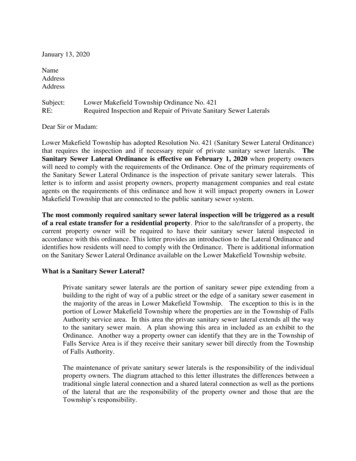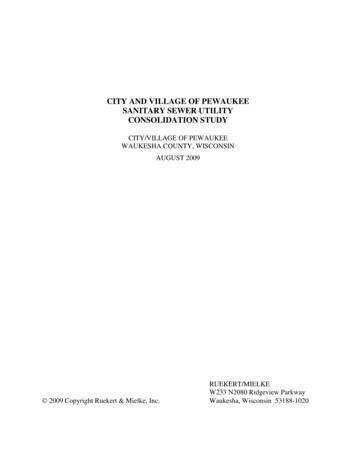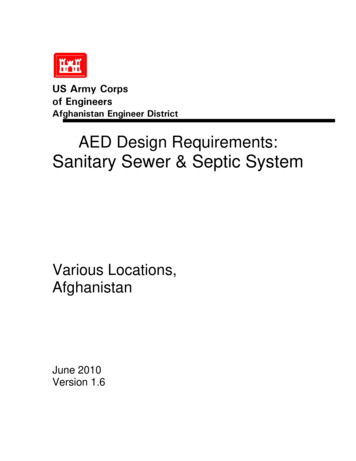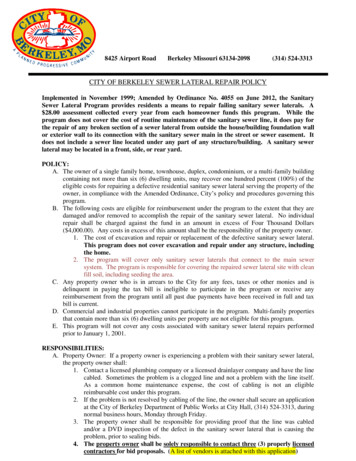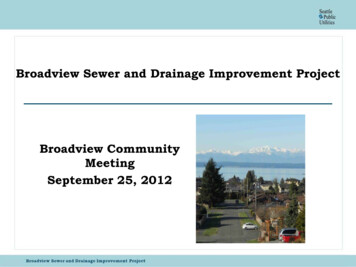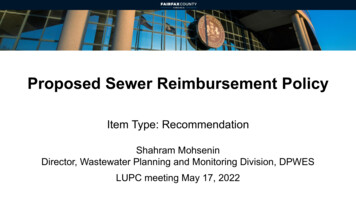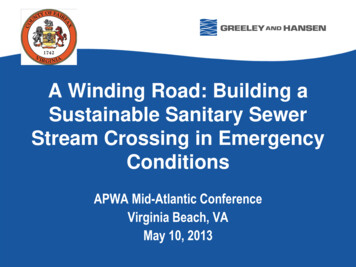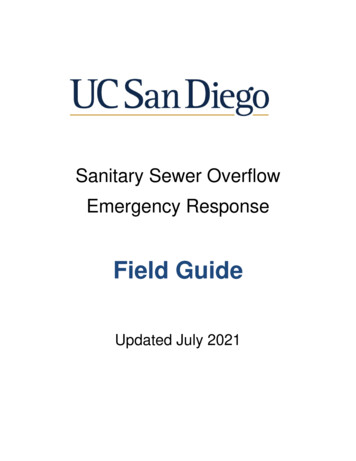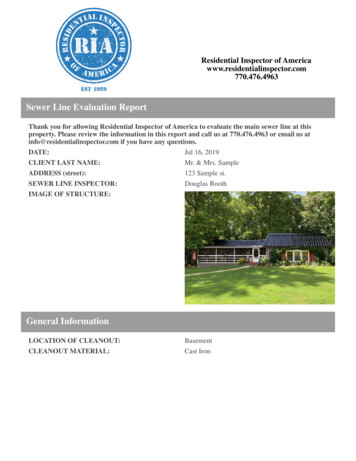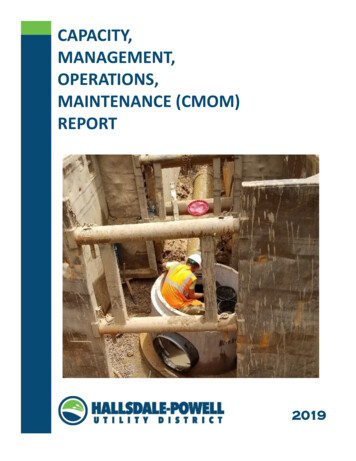
Transcription
Sanitary Sewer ionCapacityO&MAmerican Society of Civil EngineersEPA Cooperative Agreement CP-828955-01-0April 2004
Sanitary Sewer OverflowSolutionsGuidance ManualPrepared By Black & Veatch Corporation forAmerican Society of Civil EngineersUnder Cooperative Agreement WithU.S. Environmental Protection AgencyOffice of Wastewater Management Washington, DCEPA Cooperative Agreement #CP-828955-01-0April, 2004
NoticeThis guide was prepared under a cooperative agreement between the Environmental Protection Agency(EPA) and the American Society of Civil Engineers (ASCE). Any opinions, findings, conclusions, orrecommendations expressed in this publication do not necessarily reflect the views of EPA or ASCE.Additionally, neither EPA nor ASCE, nor any of their employees, make any warranty, expressed or implied,nor assume any legal liability or responsibility for the accuracy, completeness, or usefulness of anyinformation, product or process included in this publication. Users of information from this publication assumeall liability arising from such use.
AcknowledgmentsThe authors of this report wish to thank the United States Environmental Protection Agency (USEPA), theBlack & Veatch Corporation, and the American Society of Civil Engineers (ASCE) for their support of thisstudy. The authors acknowledge the critical input provided by the members of the Technical AdvisoryCommittee (TAC).Primary AuthorsPhilip M. HannanBlack & Veatch Corporation18310 Montgomery VillageGaithersburg, MD 20879(301) 921-2861hannanpm@bv.comRichard E. NelsonBlack & Veatch Corporation8400 Ward ParkwayP.O. Box 8045Kansas City, MO 64114(913) 458-3510nelsonre@bv.comContributing AuthorsImran M. KhanBlack & Veatch Corporation8400 Ward ParkwayP.O. Box 8045Kansas City, MO 64114(913) 458-3679khanIM@bv.comASCE StaffSuzanne L. RamseyASCE1801 Alexander Bell DriveReston, VA 20191-4400(703) 295-6157sramsey@asce.orgEPA StaffBarry R. BenrothEnvironmental Protection AgencyRoom 732451200 Pennsylvania Ave, NWMail Code 4204MWashington, D.C. 20460benroth.barry@epa.govSharie CentillaEnvironmental Protection AgencyRoom 7033FMail Code 2224A1200 Pennsylvania Ave.Washington, D.C. 20460Centilla.sharie@epa.govDr. Ahmad HabibianBlack & Veatch Corporation18310 Montgomery VillageGaithersburg, MD 20879(301) 921-2891habibiana@bv.comBen Marre’Black & Veatch Corporation4004 Kruse Way PlaceSuite 200Lake Oswego, OR(503) 699-7556MarreBJ@bv.comKevin J. WeissEnvironmental Protection AgencyRoom 732451200 Pennsylvania Ave, NWMail Code 4204MWashington, D.C. 20460weiss.kevin@epamail.epa.gov
Technical Advisory CommitteeIfty KhanWastewater CollectionDepartment of Public Works andEnvironmental Services, Fairfax County6000 Freds Oak RdBurke, VA 22015(703) 250-2700ifty.khan@co.fairfax.va.usDr. Mohammad NajafiCenter For Underground InfrastructureResearchConstruction Management ProgramMichigan State University205 Farrall HallEast Lansing, MI 48824-1323(517) 432-4937najafi@msu.eduMr. George L. MartinP.O. Box 775Greenwood Metropolitan DistrictGreenwood, S.C 29648(864) 943-8004georgem@emeraldis.comJohn RednerSewerage DepartmentCounty Sanitation District of Los AngelesCounty, LA1955 Workman Mill RdWhittier, CA 90601(562) 699-7411jredner@lacsd.orgMr. Joseph BarsoomDepartment of Public WorksCity and County of Denver, CO2000 W. 3rd AveDenver, CO 80223(303) 446-3431
Table of ContentsExecutive Summary. ES-1Chapter 1 - Introduction1.1. Introduction. 11.2. Objectives. 21.3. Approach . 2Task 1: Project Kick-off Meeting .2Task 2: Literature Search .2Task 3: Case Studies .2Task 4: Development of SSO Solutions.3Task 5: Development of a Guidance Manual.3Task 6: Dissemination of Informational Material .3References. 3Chapter 2 - Data Collection2.1. Introduction. 52.2. Literature Search. 52.3. Case Studies . 6References. 8Chapter 3 - Reported SSO Solution Results3.1. Introduction. 93.2. Literature Search Results. 93.3. Case Studies . 10Chapter 4 - Overview of SSO Solutions4.1. Introduction. 134.2. Capacity Solutions. 144.3. Management Solutions . 144.4. Operation, Maintenance & Rehabilitation Solutions . 15References. 15Chapter 5 - Capacity Solutions5.1. Introduction. 175.2. Capacity Assurance Plan. 175.2.1 Infiltration/Inflow .185.3. Master Planning . 205.3.1 Population Projection .205.3.2 Land Use Analysis.215.3.3 Flow & Rainfall Monitoring .225.3.4 Rainfall Analysis .235.3.5 Determination of Total Peak Design Flow.245.3.5.1 Flow Analysis Components .255.3.5.2 Determination of Average Daily Dry Weather Flow .265.3.5.3 Determination of Infiltration.265.3.5.4 Determination of Inflow .275.3.6 Hydraulic Modeling.275.3.6.1 Hydraulic Modeling Inventory .285.3.6.2 Model Set-up .295.3.6.3 Model Calibration .295.3.6.4 Model Simulations.305.3.6.5 Evaluation of Results .305.3.7 Capital Improvement Program Development .315.4. Capacity Enhancement. 315.4.1 Relief Sewers.32Solutions for Sanitary Sewer OverflowsASCE/EPA Cooperative Agreement CP-828955-01-0II
5.4.1.1 Open Cut .335.4.1.2 Microtunneling .335.4.1.3 Augor Boring.345.4.1.4 Horizontal Directional Drilling.355.4.2 On-line Replacement.365.4.3 Rehabilitation .375.4.4 Elimination of Hydraulic Bottlenecks .375.4.4.1 Bottleneck Analysis.385.4.4.2 Bottleneck Solutions.395.4.5 Wet Weather Storage Facilities .405.4.5.1 In-Line Storage.405.4.5.2 Equalization Basins and/or Off-line Storage.405.4.5.3 Peak Excess Flow Treatment Facilities (PEFTF’s).415.4.6 Pumping Station Capacity Enhancement .43References. 44Chapter 6 - Management SolutionsIntroduction. 45Asset Management . 45Environmental Management Systems . 48Benchmarking . 49Organizational Management. 51Resource Management . 516.6.1 Human Resources.516.6.1.1 Second and Third Shifts .526.6.1.2 Flexible Worker .536.6.1.3 Employee Empowerment .536.6.2 Outsourcing.556.6.3 Equipment: Ownership vs. Leasing.556.7. Information Management. 566.7.1 Geographic Information System (GIS).576.7.2 Computerized Maintenance Management System (CMMS).586.7.2.1 Trend Analysis.596.7.2.2 Proactive Maintenance Schedules.606.7.3 Internet & Web-Based Systems .616.8. Financial Management. 626.9. Legal Ordinances . 636.9.1 FOG Programs .636.9.1.1 FOG Problem .636.9.1.2 CMOM Perspective.646.9.1.3 Ordinance and Regulation.656.9.1.4 Industry/Technical Guidance.666.9.1.5 Education & Outreach.676.9.2 Private Property Infiltration/Inflow .696.9.2.1 Codes.706.9.2.2 Permitting, Inspection and Enforcement.706.9.2.3 Solutions .716.9.3 Satellite Flows.746.9.4 Municipal Codes .756.10.Permitting. 756.11.Design, Installation, Rehabilitation, Inspection & Testing Standards . 766.12.Performance Standards . 776.13.Progress Monitoring & Self Assessment Plan . 796.14.Overflow Response Plan . 806.14.1 Plan Elements .806.15.Monitoring & Reporting Plan. 816.1.6.2.6.3.6.4.6.5.6.6.Solutions for Sanitary Sewer OverflowsASCE/EPA Cooperative Agreement CP-828955-01-0IIII
6.15.1 Plan Elements .826.15.2 Public Awareness Program .826.16.Training. 836.17.Certification. 83References. 84Chapter 7 - Operation and Maintenance Solutions7.1. Introduction. 897.2. Maintenance Strategies . 897.2.1 Emergency and/or Reactive Maintenance.897.2.2 Corrective Maintenance .907.2.3 Proactive Maintenance.907.3. Collection System Maintenance Tools . 927.3.1 Hydraulic Cleaning .927.3.2 Mechanical Cleaning.947.3.2.1 Sewer Rodding.947.3.2.2 Cable or Bucket Machines.957.3.3 Hydro-Mechanical Cleaning.967.3.4 Special Mobile Units.977.3.5 Root Control Tools.977.3.5.1 Chemical Treatment.987.3.5.2 Bio-Filters and Barriers .997.3.5.3 Tree Species Selection.1007.3.6 Grease Removal Tools .1007.3.6.1 Bioremediation .1027.3.6.2 De-greasers.1047.3.6.3 Program Effectiveness.1047.3.7 Sewer Interceptor Maintenance Tools .1057.3.8 Inverted Siphon Maintenance Tools.1067.4. Collection System Maintenance Frequency & Rates . 1077.5. Facilities Maintenance Plan . 1097.5.1 Pump Station Maintenance.1097.5.1.1 Preventive Maintenance .1097.5.1.2 Screening.1107.5.1.3 Power Reliability.1107.5.1.4 SCADA .1117.5.2 Wastewater Treatment Plant Maintenance.112References. 113Chapter 8 - Condition Assessment Solutions8.1. Introduction. 1178.2. Protocols for Identifying Location of SSOs. 1178.3. Sanitary Sewer Evaluation Survey Activities. 1188.3.1 Flow & Rainfall Monitoring .1188.3.2 Flow Isolation.1218.3.3 Smoke Testing.1218.3.4 Dyed Water Testing.1228.3.5 Closed Circuit Television Inspection (CCTV).1238.3.6 Sewer Scanner and Evaluation Technology Surveys.1238.3.7 Sonar Technology .1258.3.8 Man-Entry Inspection .1268.3.9 Manhole Inspection .1268.3.10 Line Lamping (Visual Inspection) .1278.3.11 Stream Crossing Inspection.1278.3.12 Internal Corrosion Monitoring.1288.3.13 External Corrosion Monitoring .128Solutions for Sanitary Sewer OverflowsASCE/EPA Cooperative Agreement CP-828955-01-0IIIIII
8.3.14 Pumping Station Inspection .1298.3.15 Force Main Inspection & Evaluation.130References. 131Chapter 9 - Rehabilitation Solutions9.1 Introduction . 1339.2 Sewer Line Rehabilitation. 1339.2.1 Sliplining.1359.2.2 Cured-In-Place-Pipe (CIPP).1369.2.3 Fold and Form .1369.2.4 Spirally Wound Pipe .1379.2.5 Segmental Lining.1389.2.6 On-line Replacement.1389.3 Manhole Rehabilitation. 1419.3.1 Open Cut Replacement .1439.3.2 Chemical Grouting.1439.3.3 Coating Systems .1439.3.4 Structural Lining.1449.3.5 Frame, Cover & Chimney .1459.4 Lateral Rehabilitation. 1469.4.1 Removal & Replacement .1469.4.2 Cured-In-Place-Pipe (CIPP) Lateral Lining .1479.4.3 Chemical Grouting.1489.4.4 Lateral Bursting.1499.5 Spot Repair. 1499.5.1 Open-Cut Repair/Replacement .1499.5.2 Cured-In-Place-Pipe (CIPP) Lining.1509.5.3 Internal Chemical Grouting .1509.5.4 External Grouting.1519.5.5 Rubber Seals .1529.6 Disconnecting Inflow Sources. 152References. 153Chapter 10 - Concluding Remarks10.1 Summary . 15710.2 Research Needs. 158Figures and TablesFigure 2-1 Location of Utilities for Case Studies .7Figure 3-1 Number of Papers per Category.9Figure 4-1 CMOM-based SSO Solutions .13Figure 5-1 Population Density of Eastern United States .21Figure 5-2 Sample NEXRAD Rainfall Data for Washington DC Area .23Figure 5-3 Sample Rainfall Intensity/Frequency Duration Curves .24Figure 5- 4 Wastewater Flow Components.26Figure 5-5 Observed and Predicted Hydrographs .30Figure 5-6 Open Cut Installation of Sewer Pipe.33Figure 5-7 Typical Augor Boring Tunnel Head.35Figure 5-8 HDD Equipment.36Figure 5-9 Typical Pipe Bursting Equipment.36Figure 5-10 Scattergraph.39Figure 5-11 ActiFlo High Rate Treatment.43Figure 6-1 Asset Management Steps.47Figure 6-2 EPA's Plan, Do, Check, Act Model .48Figure 6-3 Benchmarking Steps .50Figure 6-4 Sample GIS Screen.57Figure 6-5 Sample CMMS Inventory Screen .59Solutions for Sanitary Sewer OverflowsASCE/EPA Cooperative Agreement CP-828955-01-0IVIV
Figure 6-6 Sample Grease Control Educational Material.68Figure 6-7 Charles County's Grease Busters.69Figure 7-1 Maintenance Activity Weights (WERF, 2003) .91Figure 8-1 SSO Management Flow Chart (General).119Figure 8-2 SSO Management Flow Chart (Detail).120Table 2-1 List of Topics Discussed at Utility Interviews.7Table 3-1 SSO Solutions from Literature Search .10Table 3-2 SSO Solutions from Case Studies.11Table 5-1 Selected Historical Excessive Infiltration Inflow Criteria.19Table 5-2 Probability of Non-Exceedance.25Table 5-3 Sewer Design Criteria .31Table 6- 1 Private Property I/I Correction Options.71Table 6- 2 Effectiveness Performance Measures .78Table 6- 3 Efficiency Performance Measures.78Table 7- 1 Activity Weighting Factors.92Appendix I – Literature SearchAppendix II – Case Studies1. Auburn Hills, MI2. Clean Water Services, Portland, OR3. City and County of Denver, CO4. Fayetteville, AK5. Miami-Dade Water and Sewer, FL6. New Castle County, DE7. Rockwood, TN8. Sacramento County Regional Sanitation District, Sacramento, CA9. Three-Rivers Wet Weather Demonstration Program, Pittsburgh, PASolutions for Sanitary Sewer OverflowsASCE/EPA Cooperative Agreement CP-828955-01-0VV
Executive SummaryThe objective of this project was to develop a Guidance Manual that presented a range ofsolutions for sanitary sewer overflows (SSOs). For the purpose of this project, an SSOwas defined as the discharge of untreated sewage from a separate sanitary sewersystem. This includes both overflows from the collection system as well as backups intohomes. This project identifies solutions for both wet and dry weather SSOs.The process of reducing SSOs involves three steps. First, the location of SSOs,particularly chronic SSOs, should be identified. Second, measures should be taken toeliminate the causes of the SSO, thereby minimizing the potential for their occurrence.Third, a proactive program that invests in maintenance, rehabilitation and capacityenhancement as appropriate is necessary to eliminate the precursors to future orprospective SSOs.Data collection included two major tasks - a literature search and case studies of nineutilities. The literature search was conducted in order to obtain key publications, articles,and other materials related to solutions for SSOs. The availability of materials related toSSOs has expanded significantly during the last 10 years. Several hundred papers wereidentified as candidates for review during the literature search. Of these, 120 papers werereviewed and summaries of each paper were developed. The extensive materialdeveloped during the literature search was used as a reference to assist in developmentof the guidance manual. Additional material located in a variety of sources includingindustry and agency web pages, as well as personal communications with project teammembers and advisory panel members also were used in assembling the solutioninformation. The SSO literature summaries provide an additional resource for agencies tolocate additional background information.Case studies were performed
Michigan State University 205 Farrall Hall East Lansing, MI 48824-1323 (517) 432-4937 najafi@msu.edu Mr. Joseph Barsoom Department of Public Works City and County of Denver, CO 2000 W. 3rd Ave Denver, CO 80223 (303) 446-3431 Mr. George L. Martin P.O. Box 775 Greenwood Metropolitan District Greenwood, S.C 29648 (864) 943-8004
